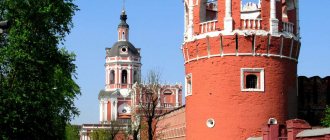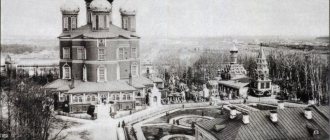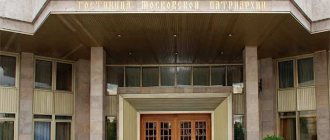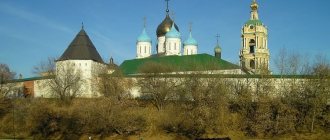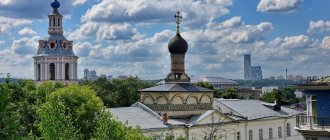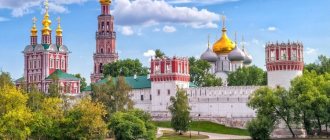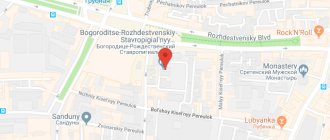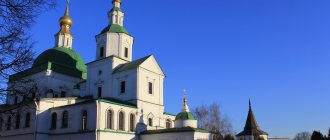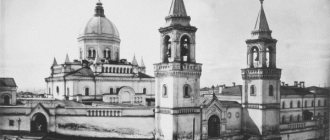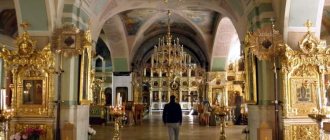Being one of the main attractions of Zamoskvorechye and the south of Moscow, the Donskoy and Danilovsky monasteries were originally located one and a half kilometers from the city ramparts, serving both as protective outposts and shelters. Both of them are interesting in their own way, but the Donskoy Monastery is more closely connected with the history of the city; there is a large cemetery here. The Danilovsky Monastery's own cemetery is located further south, bordering the Muslim cemetery.
Cemeteries were established here by imperial decree during the last plague epidemic in 1770-1771. To prevent its spread, entire blocks of Moscow buildings were burned and all medieval cemeteries within the center were dug up and removed outside the city so that the infection from the already dead would not be transmitted to the living. Outside the city, seven new large Orthodox cemeteries were established as the death toll increased dramatically. In Moscow, one third of the population—more than 200 thousand people—died from the plague that year.
- 2.1 Useful information about the Danilovsky Monastery
Founding of the monastery
In 1591, the army of the Crimean ruler, the powerful Kazy-Girey, approached Moscow itself. The city was ready for defense, but its residents were preparing for the worst. By order of the Russian sovereign Fyodor Ioannovich, a crowded religious procession was held around the capital. And the tsar sent the defenders of the city the famous icon of Our Lady of the Don, which, according to legend, was with Dmitry Donskoy during the famous Battle of Kulikovo.
Then there were several local skirmishes between Russian warriors and Tatars, however, the decisive battle never took place. The Tatar troops camped for several days and, unexpectedly for everyone, turned back.
The amazing rescue of Moscow caused universal joy and rejoicing. In honor of the great miracle, the Russian sovereign ordered the founding of a new monastery. And the place chosen for it was the territory of “Gulyai-Pole”, where the mobile army that met the Tatars was located.
The Battle of Kulikovo took place on the church holiday of the Praise of the Mother of God, so the new monastery was first dedicated to the Mother of God.
View of the towers and walls of the monastery from the street. Donskaya
Donskoy Monastery and its formation
Donskoy Monastery is one of the oldest monasteries in the city of Moscow, founded by Tsar Theodore Ioannovich in 1591-1593.
in memory of the city’s deliverance from the attack of the Crimean Khan Kazy Giray. The monastery was founded on the site of a camp church in honor of St. Sergius of Radonezh, in which the icon of the Don Mother of God was located.
According to legend, this was the same icon with which St. Sergius blessed Grand Duke Dmitry Ioannovich for the battle that took place in 1380 on the Kulikovo field, near the Don. In honor of that great victory, the people began to call the icon Donskoy (like the prince himself). This is how the monastery got its name.
History of the monastery in the XV-XIX centuries
A cathedral was immediately built in the monastery, dedicated to the icon that saved Moscow. The new stone church was called the “refectory”, and after the construction of the Great Monastery Cathedral it began to be called “Small”. Researchers suggest that the architect of the first monastery cathedral could have been the famous architect Fyodor Kon, thanks to whom the walls of the White City grew.
The monastery stood to the south of the capital, covering the strategically important Kaluga road. Together with other monasteries, it was part of a fortified ring created to defend the city from enemies.
During the Time of Troubles, the monastery was plundered by Polish troops led by Hetman Chodkiewicz. After this, the devastated monastery was not restored for several years and was subordinated to the Moscow Andronikov Monastery.
The revival of the Donskoy Monastery took place thanks to the efforts of Tsars Mikhail Fedorovich and Alexei Mikhailovich. During their reign, the monastery became popular among pilgrims, and religious processions were held through the “pious place,” in which ordinary Muscovites, noble boyars and Russian sovereigns took part.
The bell tower of the monastery with the church in the name of Saints Zechariah and Elizabeth
In 1705, the monastery welcomed a new abbot. Peter I entrusted the leadership of the monastery to Archimandrite Lawrence (Gabashvishi). The Moscow monastery began to play the role of a cultural center between Russia and Georgia, and the descendants of the Georgian royal and famous princely families were buried in the monastery.
In the 70s of the 18th century, there was a plague epidemic in Moscow, after which it was decided to no longer bury citizens in cemeteries within the city. From that time on, the monastery necropolis began to grow, and representatives of many famous noble families of Russia - the Trubetskoys, Dolgorukovs, Vyazemskys, Golitsyns and Naryshkins - found refuge there.
Like other monasteries in Moscow, the Don Monastery was badly damaged during the invasion of Napoleon's troops. She really was lucky. Despite the severe fires, all the monastery buildings remained intact and were quickly restored.
Gradually the monastery became one of the significant spiritual and educational centers. In 1834, a theological school was opened here, the graduates of which could continue their education within the walls of the seminary. It is noteworthy that children from poor families received education for free.
Great Cathedral of Our Lady of the Don
Monastery in the 20th century
The Orthodox monastery is famous for the fact that Patriarch Tikhon spent the last years of his life within its walls. After the revolutionary events of 1917, he publicly condemned the atrocities that were happening and was persecuted for this. The Patriarch was isolated from his flock, and he lived in a monastery.
In the spring of 1925, the disgraced church hierarch was buried in the Small Monastery Cathedral. The following year the monastery was closed. An anti-religious museum was created on its territory. Then a boarding school was opened here, and after that a factory and a dairy farm.
Since 1935, an architecture museum has opened on the monastery territory. Fragments of ancient buildings to be destroyed began to be brought for him from different parts of the city. Thus, high reliefs of the destroyed Cathedral of Christ the Savior, ancient tombstones from dug up cemeteries and carved frames taken from the Sukharevskaya Tower came to the former monastery.
Small Cathedral of Our Lady of the Don
A few years after the Great Patriotic War, the Small Cathedral was returned to the church, but the monastery itself was not restored. The question of reviving monastic life was raised in 1982, but several years of discussions did not lead to any result. Only in 1990 did the monastery buildings become the property of the church. After this, large-scale restoration work began here.
What can you see in the monastery
Visitors enter the monastery through the gates of the high bell tower, which houses the temple of Zechariah and Elizabeth. At the entrance you can see several picturesque hagiographic icons on the walls.
The oldest surviving temple is the Small Cathedral. The new or Great Monastery Cathedral appeared at the end of the 17th century.
This was the time when large-scale stone construction was carried out in the monastery. At the same time, powerful walls with openwork towers were erected around the monastery.
Alexander Nevsky Church
Since the end of the 19th century, the Church of St. John the Climacus has stood here. It was erected with the money of General Tereshchenko and served as a family crypt. Another crypt of members of the Zubov family is located in the Church of Alexander Svirsky, the round building of which looks like a classical rotunda.
The picturesque Church of St. John Chrysostom became the tomb of the Pervushin merchant family. Another church, dedicated to the Tikhvin Icon of the Mother of God, completes the northern gate of the monastery.
Most of the monastery territory is reserved for the necropolis. It appeared at the end of the 17th century and by the 19th century it turned into a place where high-born merchants and the elite of the Russian nobility were buried. Close relatives of the poet A.S. Pushkin lie in the monastery cemetery.
Here are the graves of the famous Russian mechanic N. E. Zhukovsky, the historian V. O. Klyuchevsky and the landowner Saltychikha, known for her cruelty. Among other graves you can see the tombstones of Russian generals V. O. Kappel and A. I. Denikin, philosopher A. I. Ilyin, as well as writers I. S. Shmelev and A. I. Solzhenitsyn.
Church of St. Tikhon, Patriarch of All Russia
Russian Orthodox Church
Story
The monastery was founded in 1591 in memory of the miraculous deliverance of Moscow from the invasion of the Crimean Khan Kazy-Girey; in the same year the first stone cathedral was built in the name of the Don Icon of the Mother of God. Resumed by Tsars Mikhail Feodorovich and Alexei Mikhailovich. Stone walls and towers were erected in 1686, and in 1693 a new cathedral in honor of the Don Icon of the Mother of God was consecrated.
In 1745 the monastery was classified as stauropegial. From the end of the 17th century. The monastery was the tomb of the Moscow nobility. In the monastery cemetery, the largest preserved in Moscow, the flower of the Moscow nobility is buried, many figures of Russian culture - P.Ya. Chaadaev, V.F. Odoevsky, V.O. Klyuchevsky, O.I. Bove and others, in the Sretensky Church there is a tomb of the Georgian kings and princes, in the Mikhailovsky Church there is a tomb of the Golitsyn princes. In 1914, a temple was consecrated on the new territory of the cemetery adjacent to the monastery.
In 1922-25. His Holiness All-Russian Patriarch Tikhon was in custody in the monastery; in 1925, in the Small Cathedral of the monastery of St. Tikhon was buried. In 1926 the monastery was closed. Until the end of the 1920s. Monastic life continued in the monastery. Then the monastery premises were occupied by an anti-religious museum, a boarding school, courses, and a dairy farm. In 1927, the Church of St. Seraphim of Sarov and Blgv. book Anna Kashinskaya at the new cemetery was rebuilt into the first crematorium in Moscow (architect D.P. Osipov). In 1929, all the monastery churches were closed, since 1934 the Museum of Architecture was located in the monastery, and fragments of demolished Moscow churches were brought to the territory of the monastery.
Now the monastery contains six sculptural fragments taken from the walls of the blown-up Cathedral of Christ the Savior, parts of the decoration of the Triumphal Arch, the Church of the Assumption of the Virgin Mary on Pokrovka, St. Nicholas “Grand Cross” and others. Divine services in the Small Cathedral were resumed in 1949. After the return of the cathedral, a chrism oven was installed in its refectory for preparing the holy myrrh for all parishes of the Russian Orthodox Church. At the beginning of November 1982, L.I. Brezhnev signed an order to transfer the monastery to the Moscow Patriarchate to house the Patriarch’s residence in it, but the death of the General Secretary that followed a few days later suspended the execution of this decision, and in May of the following year the Danilovsky Monastery was given to the Patriarchate.
The Big Cathedral was consecrated in August 1991. On February 19, 1992, after a fire in the Small Cathedral, the miraculous discovery of the relics of St. Tikhon, Patriarch of All-Russia, which were placed in a shrine and subsequently transferred to the Great Cathedral, where they rest on the northern part of the sole.
Divine services in the Church of St. Seraphim of Sarov at the cemetery were resumed in 1998.
At the entrance to the monastery there is military equipment - a Dmitry Donskoy tank, a cannon and armored personnel carriers. During the Great Patriotic War, an entire tank column of 40 units of equipment was built at the expense of believers and clergy. The name of one of the greatest Russian prince-commanders, Dmitry Donskoy, was written on the armor of the vehicles. After the war, the surviving vehicles were kept in museums of the Armed Forces in Moscow, Leningrad and Tula. In 2003, it was decided to donate them to the Donskoy Monastery.
Temples and chapels
- Small (old) Cathedral of the Don Icon of the Mother of God with chapels of the Great Martyr. Theodore Stratelates and St. Sergius of Radonezh (1591-93, probably architect Fyodor Kon; bell tower and chapels - 1679);
- The Great Cathedral of the Donskoy Monastery (1684-98, built on in the mid-19th century, iconostasis 1695-99) - summer, in the basement - the Church of the Presentation of the Lord;
- Church of the Archangel Michael (1714, rebuilt in 1806-1809, hospital, with the Golitsyn tomb);
- the temple of the Tikhvin Icon of the Mother of God above the southern gate (1713-14, probably architect I.P. Zarudny);
- temple of the right Zechariah and Elizabeth above the western gates, in the bell tower (1730-32, architect D. Trezzini, then A.P. Evlashev, with the participation of D.V. Ukhtomsky - 1752-55);
- temple of St. Alexander Svirsky (1796-98, tomb of the Zubovs, restored after a fire in 1813);
- temple of St. John Climacus (1898, Tereshchenko tomb);
- temple of st. John Chrysostom (1888-91, architect A. Vincent, tomb of the Pervushins) upper temple; VMC. Catherine - lower temple;
- temple of St. Seraphim of Sarov and Blgv. book Anna Kashinskaya at the new cemetery of the Donskoy Monastery (1902-10; consecrated 1914 - architect Z.I. Ivanov; Ordzhonikidze St., 4), chapels of the Dormition of the Blessed Virgin Mary and Equal-to-the-Apostles Mary Magdalene, the Descent of the Holy Spirit and All Saints ;
- chapel-tomb of Levchenko (beginning of the 20th century, architect I. Klein);
- temple of st. Tikhon, Patriarch of All-Russia, and the lower church of Blessed. book Vyacheslav Czech (1998);
- Church of St. George the Victorious (2000).
Shrines
- in the Small Cathedral: the venerated icons of the Mother of God “Theodorovskaya” and “The Sign”; Donskaya Icon of the Mother of God under the canopy; near the walls of the cathedral is the grave of St. Tikhon martyr. Yakova Polozov;
- in the Great Cathedral: the miraculous Don Icon of the Mother of God; cancer with the relics of St. Tikhon, Patriarch of All Russia;
- in the chapel-tomb of Levchenko there is a mosaic icon of St. Nicholas.
Divine service
In the Small Cathedral there is daily midnight office and hours at 7.00, Liturgy at 8.00, at 17.00 vespers and matins (on Wednesday with an akathist to the Don Icon of the Mother of God, on Sunday with an akathist to St. Tikhon); on Sundays and holidays - Liturgy at 7.00 in the Small Cathedral and at 10.00 in the Big Cathedral, the night before the all-night vigil - at 17.00. In the church of St. Seraphim of Sarov on Sundays Liturgy at 10.00.
Extra-liturgical activities
The monastery operates a Sunday school, icon-painting and restoration workshops, and an icon and bookstore is open daily.
Viceroys
- 1991-2009 — Archimandrite Agathodor (Markevich)
- 2009-2012 — Metropolitan Kirill (Pokrovsky)
- 2012-2019 — Bishop Paramon (Dove)
- 2019-2020 — Bishop Thomas (Demchuk)
- 2020 - Metropolitan Evgeniy (Kulberg)
- from 12/08/20 - Metropolitan Feognost (Guzikov)
Shrines
The main shrine of the men's monastery is considered to be the Don Icon of the Mother of God (16th century), which was painted by the famous Russian iconographer Theophan the Greek. The image, revered by believers, is constantly in the State Tretyakov Gallery, but once a year it is brought to the walls of the monastery.
In the Great Monastery Cathedral there is a shrine where the relics of Patriarch Tikhon rest. In addition, pilgrims come to bow to the burial place of Yakov Polozov, who was a cell attendant under Patriarch Tikhon.
Monastic necropolis
How to get to the monastery
The monastery is located 5.5 km south of the Moscow Kremlin. The monastic territory is 1.1 km from the Shabolovskaya metro station, 1.5 km from Leninsky Prospekt and 2 km from Tulskaya. Trams No. 14 and 39 stop nearby. You need to get off at the “Peoples' Friendship University” stop. In addition, the entrance to the monastery can be reached on foot from Leninsky Prospekt - from the public transport stop “Institute named after. Kurnakov."
Attraction rating
Rating 5.00 [1 Vote]
| ← MONASTERIES OF MOSCOW | MOSCOW → |
Church of the Archangel Michael in the Donskoy Monastery
The Orthodox Church of the Archangel Michael in the Donskoy Monastery (Moscow) is a functioning church. Address: Donskaya Square, 1, building 20 (nearest Tulskaya metro station).
Other names of the church
Arkhangelsk Church; Michael the Archangel Church; St. Michael's Church.
Date of construction of the surviving church building
1806-1809
Architects
- 1806-1809: - presumably - Egotov I.V.
- 2001: Trubnikova T.V. — interiors, interior/exterior decor (iconostasis).
Historical confession
Orthodoxy.
Religious affiliation
Russian Orthodox Church, Moscow Patriarchate.
From the history of the temple
The history of the emergence of the Church dates back to 1714. That year, the Church of St. Euthymius the Great was erected in the corner of the southern part of the Donskoy Monastery. The temple was built with donations from steward Ivan Ivanovich Durnovo.
Rebuilding the Church
In 1806-1809 The Church of St. Euthymius the Great was rebuilt. The reconstruction work was presumably carried out according to the design of the architect I.V. Egotov. After which the rebuilt temple was reconsecrated into the Church of the Archangel Michael. Subsequently, it became the family tomb of the Golitsyn princes.
